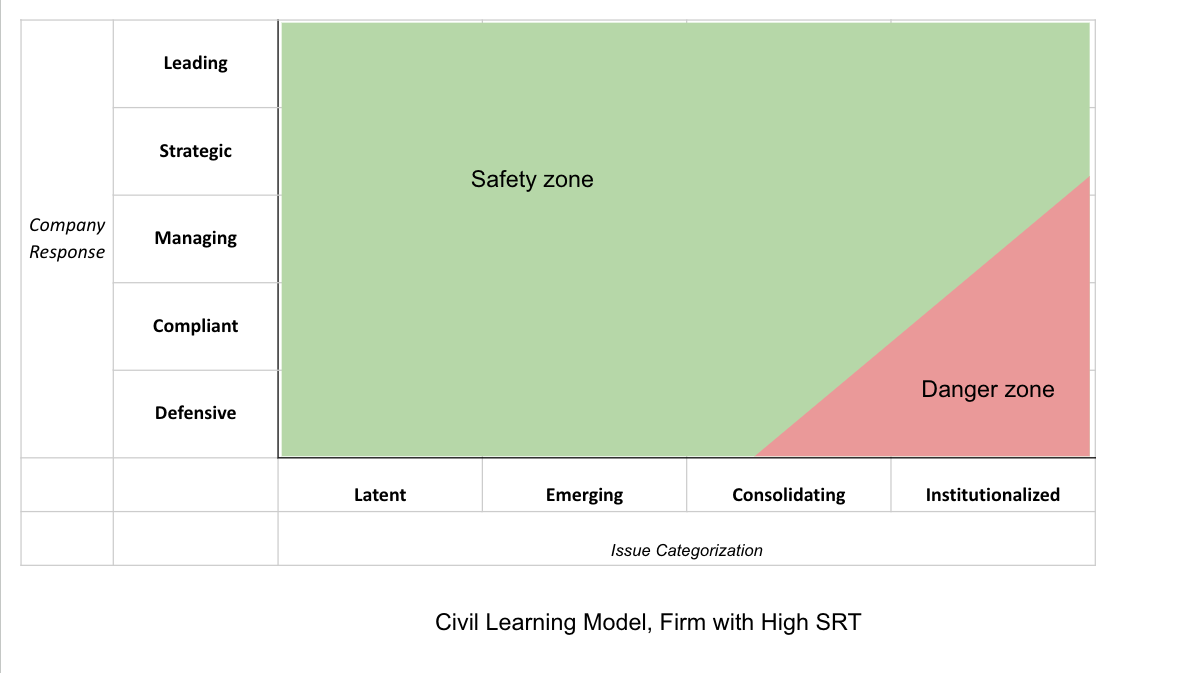Part 4: Duties and Stakeholder Theory
56 What is the Zadek Civil Learning Model?
In the last two Questions, we studied how a firm’s SRT varies by its industry and value proposition. In this Question, we study a valuable framework that incorporates this analysis and adds the ability to examine a particular issue facing the firm. This model is based on the “Civil Learning Tool” in Simon Zadek’s Harvard Business Review article, The Path to Corporate Responsibility. (Some of the terms and application have been adjusted from Zadek’s characterization for our purposes.)
First, an issue that a firm faces may be categorized in one of four ways, depending on the number, power, and interest of the company’s stakeholders who care about the issue.
| Category | Description |
| Latent | Activists may care deeply about the issue, but the public in general is not concerned. Only specialized businesses make responding to this issue part of their value proposition. |
| Emerging | Media reporting on the issue begins to increase, and businesses in general begin to consider whether the issue may impact operations. Litigation may be threatened by activists. |
| Consolidating | Many businesses are responsive to the issue, and the public at large is aware. There may be proposed legislation and class actions against companies who are not responsive to the issue. Businesses may begin to establish voluntary standards and certifications around the issue. |
| Institutionalized | Legislation has likely been passed to respond to the issue, or litigation over the issue has become common. Most businesses have plans to respond to the issue as part of routine operations. |
After reading this table, it might remind you of the discussion we had previously about child labor and how ethical issues often become legal issues with the passage of time. Child labor began as a latent issue, but eventually became a heavily institutionalized issue in the United States. Also, in terms of the stakeholder categorization we have done, as we move down the scale from “latent” to “institutionalized”, stakeholder interest generally moves from “low” (few people care strongly about the issue) to “high” (many people care strongly about the issue).
Second, how a company responds to the issue may also be categorized, according to the following table.
| Category | Description |
| Defensive | The company denies the issue is a problem, or denies responsibility for the problem. |
| Compliant | The company complies with any laws surrounding the issue, but goes no further. |
| Managing | Management begins to consider how the issue may create value for the company, in addition to merely complying with the law. |
| Strategic | The company’s core strategies integrate the company’s response to the issue. |
| Leading | The company leads the industry on the issue, helping create new standards and practices. The issue may form an important part of the value proposition offered by the company. |
For example, Theranos was famously in the “Defensive” stage of civil learning when stakeholders began to question its technology. The company stated that accusations were “factually and scientifically erroneous and grounded in baseless assertions by inexperienced and disgruntled former employees and industry incumbents.” In contrast, Patagonia might be characterized as “Leading” on sustainability issues such as the effect of micro-plastics on aquatic life, with the company “investigating ways to minimize fiber shedding”, “supporting scientists”, “investing in … organizations … to address marine plastics pollution”, and “communicating … with our customers and the broader public” about the issue.
Third, we can combine these two tables into one unifying framework showing the level of the issue, and the company’s response. In the following graphs, the x-axis shows the issue categorization, from Latent to Institutionalized. The y-axis shows the company’s response, from Defensive to Leading. Then, we can categorize portions of the graph as a “safety zone” or “danger zone” based on the company’s SRT. For example, a company with a very low SRT like Patagonia which competes on CSR / ESG issues in an industry without significant market power, the safety zone is relatively small. Patagonia likely needs to be at the “Strategic” or “Leading” level on issues its stakeholders care about.

In contrast, for a firm with a very high SRT, like a budget grocer competing on price in an industry with few substitutes, the safety zone is much larger, because the firm can “get away with” more before needing to respond to even a consolidated issue.

For a firm in its safety zone, CSR / ESG issues represent opportunities. Can the firm begin to lead its industry on an issue before an institutionalized response? For a firm in its danger zone, CSR / ESG issues represent threats. Enabling stakeholders, such as government regulators, may begin to respond in significant ways as part of an institutionalized response. (You can make a copy of these graphs in Google Slide form, here.)

Exercises
- Amazon has faced substantial scrutiny over its labor practices in recent years. (See results from this Google News search.) How would you categorize Amazon according to the Civil Learning Model?

